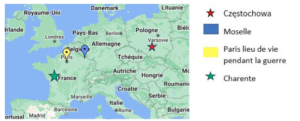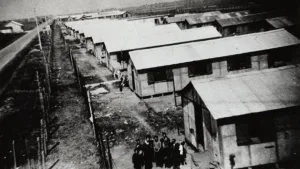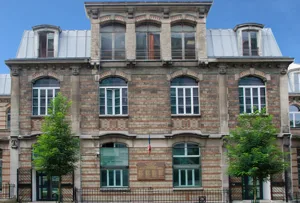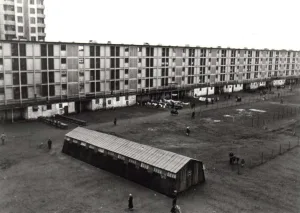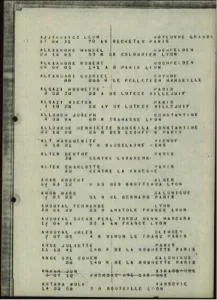Léon AJZYKOWICZ
Introduction
The aim of the Convoy 77 non-profit organization is to retrace the life stories of people who were victims of the Holocaust during the Second World War and who were deporte on the 77th convoy from Drancy, France, to the Auschwitz concentration camp on July 31, 1944.
Working as part of this European project, we are a group of French 9th grade students from the Les Blés d’Or secondary school in Bailly-Romainvilliers, in the Seine-et-Marne department of France. We are researching victims’ life stories by using records provided by the Convoy 77 team and available on the Yad Vashem and Shoah Memorial websites.
We wrote this biography in memory of Léon Ajzykowicz, a 12-year-old Jewish boy who was one of the 1306 people who were deported on Convoy 77.
Birth and family background
Léon Ajzykowicz was born on February 17, 1931 in Moyeuvre-Grande in the Moselle department of France.
His father, Henri Ajzykowicz, was born on February 2, 1902 in Częstochowa, Poland.
His mother, Rachel Tenenbergck, was born on May 31, 1909 in Częstochowa, Poland.
His younger sister, Célestine Ajzykowicz was born on November 29, 1932 in Yutz in the Moselle department of France.
Family background
Léon’s parents left Poland during the Great Depression of 1929, when the population became increasingly violent and aggressive towards Jews.
They moved to Moyeuvre-Grande in the Moselle department of France, probably because it was easier to integrate into an area where German was still widely spoken. They stayed there until the Second World began in 1939.
Germany invaded Poland on September 1, 1939, and as a result, France and the United Kingdom declared war on Germany on September 3.
520,000 people were evacuated from the border area between the Maginot Line and Germany: this became known as the exodus. The Ajzykowicz family thus moved to Juillaguet in the Charente department of France. Nazi Germany invaded France, Belgium, Luxembourg (a neutral country) and the Netherlands on May 10, 1940. By June 1940, there were over 270,000 refugees in Charente, plus the 85,000 who had been evacuated from Moselle in September 1939, as well as thousands of Spanish Republicans. The family was offered accommodation in a little village with a population of just two hundred. In total, seven families were sheltered, kept hidden or were rescued in Charente, and only one Jew was arrested in Juillaguet.
On June 22, 1940, according to the Armistice agreement, France was divided into two zones, separated by a demarcation line. The Charente department was itself cut in two. Nazi Germany occupied the northern half of the country and annexed Alsace and Moselle.
It is not known what happened to the family between September 1939 and July 1941; perhaps they tried to cross the demarcation line into the free zone in the southern half of France. The next trace of them is in 1941, when the parents were arrested and interned in the Poitiers camp in mid-July.
The Poitiers internment camp.
The Poitiers camp, which was founded in 1939, was initially intended to hold Spanish refugees. It was on the Limoges road out of Poitiers and was managed by the French authorities. In the Second World War, it was used as an internment camp for Jews, gypsies and members of the Resistance. Living conditions were tough: there was not enough food, a lack of heating and equipment, and diseases were rife. In 1942, there were 456 internees in the camp, which could accommodate up to 900 people. The camp was periodically cleared when Jews were deported. It was made up of separate barracks for Jews, gypsies and Resistance prisoners. Nothing is left of it today, but in 1985 a memorial was erected on the site.
We discovered that Léon’s parents were deported in 1942: Henri Ajzykowicz, aged 40, was deported on July 20, 1942 on Convoy No. 8 from Angers to Auschwitz. 14 of the 827 people on this convoy survived, but Henri was not one of them and never returned to France. His wife Rachel, aged 32, was deported on November 4, 1942 on Convoy 40 from Drancy to Auschwitz-Birkenau. Of the 1000 people who were deported on this convoy, 4 survived, but Rachel was not among them.
The next trace of Léon and his sister Célestine is when they were placed in an orphanage in Paris in 1943. They were sent to the Lamarck center, a children’s home run by the UGIF (Union Général des Israelites de France, or General Union of French Jews). What happened to the children from the time their parents were arrested in 1941 to when they arrived in Paris in 1943? Might they have been placed with a foster family?
The Vichy government had founded the UGIF in 1941 at the request of the Germans. Following a series of roundups carried out between July and October 1942, the UGIF opened a number of children’s homes. They were supervised by the Commissariat aux Questions Juives (Commission for Jewish affairs) and the Gestapo. The UGIF took care of young people who had been left behind when their parents were arrested, or children who had also been arrested and then released from Drancy internment camp.
70 avenue Secrétan, Paris.
Following an Allied air raid on April 20, 1944, which damaged the Lamarck home, Célestine, Léon and some of the other children were moved to a different UGIF center at 70 avenue Secrétan in the 19th district of Paris. In total, 154 children had to be moved to other UGIF homes. The home at 70 avenue Secrétan was in the former Lucien de Hirsch Jewish school. On the eve of the Second World War, there were 350 students at the school, where they were taught religion and a broad range of other subjects. This was Léon Ajzykowicz’s last known address.
During the war, some of the children housed there came from Paris, but many were from the east of France. The UGIF worked to have children released from Drancy to avoid them being deported. Sometimes secretly, sometimes not, the UGIF placed children with non-Jewish foster families or “nannies”, if possible in the countryside. One such person was Ehoud Loeb. In early 1943, the UGIF succeeded in having children released from Drancy on condition that they were cared for in their children’s homes. They were known as “blocked” children, since they were not allowed to leave and the Gestapo knew where they were.
In her diary, Le journal d’Hélène Berr, written during the war, Hélène describes how she and her sisters wanted to go to a UGIF home but that a Mr. Katz told them: “You don’t belong here! If I have any advice to offer you, go away.” It is clear from this passage that the UGIF staff were aware that the children were at risk of being deported by the Germans.
SS commander Aloïs Brunner, Eichmann’s right-hand man, was put in charge of Drancy camp and was determined to arrest as many Jews as possible. In 1944, in retaliation for an attack on the Germans, he gave the order for all Jewish children living in the UGIF homes to be arrested.
Célestine, who was 11 years old and Léon, who was 13, were arrested during a roundup on the night of 21-22 July, 1944. Many other UGIF homes (Secrétan, Vauquelin, Ecole du travail, Saint-Mandé, Louveciennes) were raided at daybreak. Sadly, they were all deported less than a month before Paris was liberated on August 25, 1944.
Yvette Levy recalls that the day after she was interned in Drancy, all the children from the UGIF homes arrived, other than those from a home in Neuville. The SS officer who had been sent to Neuville to arrest them hadn’t had the courage to do it. When he got back to Drancy, Brunner was furious and ordered him to go back and bring them all in.
During the Second World War, the Nazis used Drancy as a transit camp. 70,000 people were interned there.
Léon and Celestine were deported on Convoy 77, the last of the large deportation transports from Drancy to Auschwitz, on July 31, 1944. They were taken by bus to Bobigny station and then spent several days on a train, in cattle cars. 1309 people, including 324 children, were deported on this convoy.
Yvette Levy describes how people were crammed “into a huge cattle train with SS men between each car, with machine guns”. They sang as they left Drancy. On the train, there was “a two-week-old baby who travelled in a cardboard box that served as a cradle, and a bedridden old man who should not have had to travel 60 miles in a cattle car only to die” before the train even got to Auschwitz.
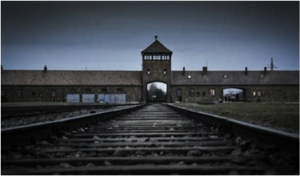
Léon was killed in the gas chambers soon after he arrived in Auschwitz. His official date of death was later declared to have been August 5, 1944. According to French law, he must have died on or before that date, as it is not possible to establish the exact date. However, since Léon was so young, he must have been sent to his death during the selection process when the convoy arrived at the camp on August 3, 1944. Auschwitz was a forced-labor and extermination camp. It was founded on April 27, 1940 and closed on January 27, 1945. The camp was run by the SS, and prisoners arrived by train. As soon as they arrived, they were sorted according to age, gender and ability to work. The weaker prisoners were usually taken straight to the gas chambers, but sometimes shot. This is what happened to Léon, who was just 13 years old.
Célestine, his younger sister, was deported on the same convoy and met the same fate as her brother.
On the Yad Vashem website, a Xavier Messaliti from Jerusalem, Israel, submitted a testimonial about Léon and his sister on April 4, 2016..
Mr. Messaliti speaks fluent Hebrew. Some of his family live in Israel. He is a genealogist and has written several biographies of people who were deported on convoy 77, possibly as a memorial to them or on behalf of an extended family member who survived.
Several members of the Ajzykowicz family were deported and died during the Second World War. This family tree shows Henri Ajzykowicz’s twin brother and his children Léonia and Adam, all of whom were deported in August 1944.
Sources
- L’école Lucien de Hirsch de 1901 à 1940 by Roger Berg, pages 13 to 16
- La Shoah by Serge Klarsfeld, pages 17 to 19
- Leon Ajzykowicz (yadvashem.org)
- LMJ_181_0153.pdf
- Camp de Poitiers (Vienne), 1940-1944 – Mémorial des Nomades de France (memorialdesnomadesdefrance.fr)
- Base des morts en déportation (1939-1945) – Leon AJZYKOWICZ – Mémoire des hommes (defense.gouv.fr)
- AJPN.org


 Français
Français Polski
Polski
